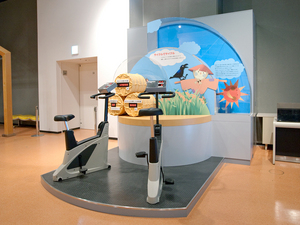Nagoya City Science Museum
TOP > Exhibition Guide > Keyword Search > Starting with "S" > Solar energy > By-Cycle
By-Cycle



Purpose of Exhibition
All creatures including animals and plants cannot live without sunlight. The sun is the source of energy to all living creatures. Rice, our staple food, is also raised under sunlight. In this exhibit, however, you, instead of the sun, have to turn the pedals of a bicycle to provide energy for rice. How much energy do we need to give rice before it produces a grain of it?
Additional Knowledge
[Solar Energy]
The Earth is at about 150 million kilometers from the sun. The Sun emits its energy to space at 0.38 octillion Jules every second. This huge number does not come across to you, but this much energy can boil all the water on earth in less than 10 seconds! The Earth receives solar energy at a tiny fraction of whole, that is less than 1/2,200,000,000. However, this small portion of energy drives total earth system, atmospheric phenomenon, such as rain, snow or wind, cultivate plants, creatures and human.
[Rice]
We take wide variety of food every day, but rice is the staple of Japan. Rice is seeds of rice plant. Plants create nutrients for itself from carbon dioxide, water and solar radiation through photosynthesis. This nutrients produces leaves or stems, and is stored as seeds for the next generation. So, for making rice, how much a rice plant uses solar energy to create rice seeds? Let's do a math a little.
[To make one grain of rice from solar energy]
Suppose that we can take rice of 10 bales (600kg) from a 1000 squre meter of rice field. If we start rice seedling planting in June, and harvest them in the end of October, then, it would take five months to reap rice. Assume that this rice field receive solar energy for 12 hours everyday, the total energy would be as follows in consideration of the fact that the angle of the sun differs according to the time of a day;
(Eq.1) 1.37[kW/m2] x 24/pi x 1000[m2] x 150[days] = 1.57 x 106[kWh]
The first section of the eq.1, 1.37[kW/m2], is called the solar constant, that is a solar evergy received by one square meter of the surface of the Earth every second.
As we assumed that 600kg of rice could be taken from this much energy, and one grain of rice is approximately 0.02g, then we can induce that it needs 52.33[Wh] of solar energy to get one grain of rice (eq.2).
(Eq.2) 1.57 x 106[kWh] / ( 600[kg] / 0.02[g] ) = 52.33[Wh]
In the exhibit, you pedal a bike for 60 seconds at approximately 120W, that generates 2Wh energy (eq.3). Hang in there!
(Eq.3) 120[W] x 60[second] / 3600[second/hour] = 2[Wh]
Thus you obtain 0.038 grain of rice through this activity (eq.4).
(Eq.4) 2[Wh] / 52.33[Wh] = 0.038[grains]
It is a only small part of a grain even though you pedaled so hard! Because a bowl of rice would carry about 4000 grains, you have to try this machine for more than 100,000 times to fill a bowl. It is the solar energy that has amazing power.
It is not exactly that simple. There are cloudy or rainy days in which the solar radiation is very weak, and, the growth of plants is affected by climate such as temperature or precipitation. The equations above are just thought-experiment. Thus we conlude that a grain of rice needs such that much energy.
Article by Tetsuro Ojio, curator
